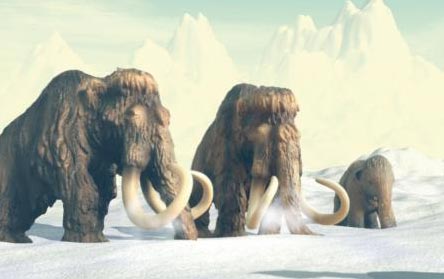Calls for the Start of the Holocene to be put Back 2,000 Years due to Lack of Mammoth Belches
American Scientists have linked the extinction of mammalian megafauna by humans to the loss of methane from the atmosphere which in turn led to a global cooling event. In a paper published in the scientific journal “Nature Geoscience” a team of scientists from the University of New Mexico have put forward a theory that the killing off of a number of large mammal species by humans led to the removal of a substantial amount of methane from the atmosphere. This brought on a period of substantial cooling that severely affected temperatures in the Northern Hemisphere.
This cooling period is known as the Younger Dryas and scientists claim that this event was brought on when the extinction of the mega fauna led to the loss of their planet warming burps.
Mammalian Megafauna
Studies of ice cores indicate that the Younger Dryas event began about a thousand years after mass human migrations into the Americas from across the Bering Strait land bridge that linked Siberia to Alaska. With mass human migrations into the Americas this put pressure on the populations of giant herbivores such as Mammoths, Mastodons and ancient camels as these animals were hunted by the human migrants. With the extinction of these animals, the atmosphere would have lost the methane they contribute caused by the process of digestion of tough plant material.
The scientists postulate that the loss of these methane producing animals contributed to the cooling event known as the Younger Dryas which saw temperature drops in parts of the Northern Hemisphere ranging from 4 degrees to 8 degrees Celsius.
According to ice core studies, the Younger Dryas event began about a thousand years after mass human migrations into the Americas 13,400 years ago, near the end of the last ice age. Within a thousand years of the human migrations more than 114 species of large plant-eaters became extinct and the study links the loss of the methane these animals would have produced with the cooling event. Methane is a powerful greenhouse gas, twenty times more effective than carbon dioxide when it comes to trapping heat in the Earth’s atmosphere and contributing to global warming.
As they digest plant material, large herbivores give off the gas, which, contrary to popular belief, escapes via the head in the form of burps and belches.
Could the Extinction of Mega Fauna Helped Cause Global Cooling?
Picture credit: Schleich of Germany
Could the extinction of mega fauna such as the Woolly Mammoth (M. primigenius) have led to a change in the Earth’s climate?
To view a range of prehistoric mammal soft toys and dinosaur stuffed animals: Prehistoric Animal Soft Toys.
Study leader Felisa Smith of the University of New Mexico, stated that the methane was not released as these animals broke wind:
“Eighty to ninety percent of methane produced is in the form of a burp.”
At the onset of the Younger Dryas cooling event, atmospheric methane concentrations dropped two to four times faster than at any other period in our planet’s history according to the ice core studies. The fall was caused by all those missing methane burps that would have been produced by the herbivores.
Felisa Smith added:
“We estimate that just under ten teragrams [about ten million tons] of methane would have gone missing when these animals went extinct.”
Ice Age Atmospheric Conditions
As Ice Age atmospheric methane concentrations were about one third of what they are now, the missing emissions would have had a magnified impact, accounting for at least 12 to 15 percent of the methane reduction the researchers claim.
Traditionally geologists have said humans are now living in the Holocene epoch, which began 11,500 years ago. Smith and her team are among scientists who argue that Earth has entered a new age, characterised by widespread, human-wrought change, the Anthropocene. Other scientists have claimed the onset of the industrial revolution in the 18th Century should mark the dawn of a new geological age, highlighting the profound effect mankind has had on the Earth’s climate. However, if it is assumed that humans were responsible for the Ice Age die-offs, the advent of the Anthropocene should be pushed back to 13,400 years ago, into the Ice Age, the study authors say.
Felisa Smith commented:
“Any way you spin it, humans had a discernible effect on the environment prior to the beginning of the Holocene.”







Leave A Comment